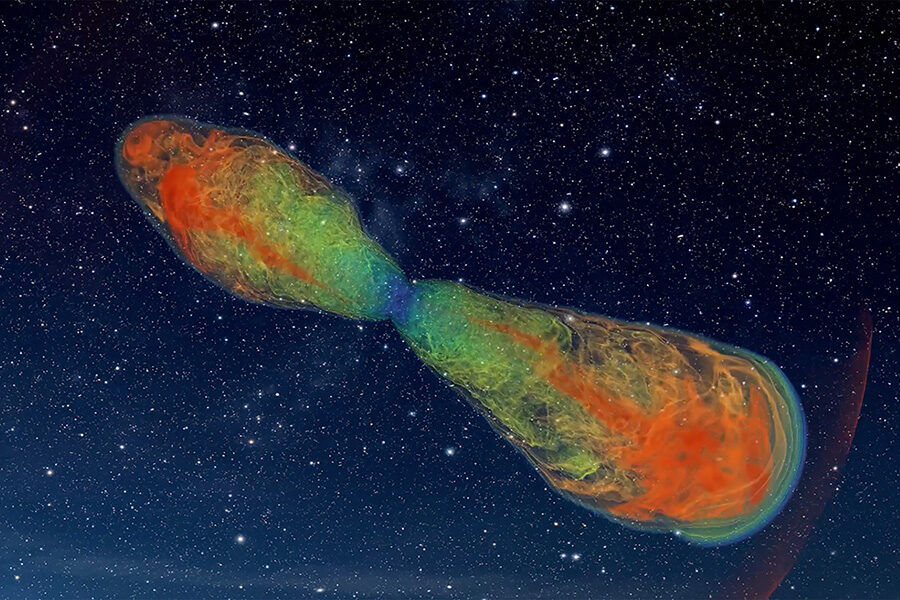Massive, dying stars — behemoths tens of times the Sun’s mass — should emit gravitational waves that we can hear with LIGO.

Ore Gottlieb / CIERA / Northwestern University
A team of astronomers has uncovered a new possible source of gravitational waves: the cocoon of hot, dense gas that forms within a massive, dying star. This source is within reach of the recently begun observing run of the Laser Interferometer Gravitational-Wave Observatory (LIGO).
Hefty stars with 20 to 40 times the Sun’s mass die in particularly spectacular fashion. First the center gives way, forming a black hole that immediately begins to feed. This process powers two opposite jets that drill their way out of the star. As the jets ram their way through the star’s outer layers, they amass a sheath of hot, dense star-stuff. For several seconds — until the jets break out of the star completely — the cocoon of gas that's wrapped around them creates ripples in spacetime, or gravitational waves.
This jet-cocoon is what Ore Gottlieb (Northwestern University) and colleagues only recently realized can emit gravitational waves.
“To be honest, I didn't look for cocoons; I was interested in another source of gravitational waves,” Gottlieb says. “But these cocoons were too strong to ignore. . . .It was more or less by chance that I started to try to understand their gravitational wave emission.”
It wasn’t immediately obvious that these gravitational waves would have the right pitch and volume for LIGO to “hear” them. To find out, Gottlieb’s team ran computer simulations that followed the jets — and the cocoons around them — all the way from their launch near the black hole to where they punch through the stellar surface and escape to space. They then calculated the resulting gravitational-wave signal. Gottlieb presented the research during a press briefing at the 242nd meeting of the American Astronomical Society (preprint available here).
Unlike the happy bloops and chirps of inspiraling black hole pairs, the signal from an emerging jet-cocoon sounds more like the eerie howl of wind. Not only would the signal be distinct, it would be loud — loud enough, even, to be picked up by LIGO in the observing run that just started May 24th.
Even more critically, those gravitational waves would be at frequencies within LIGO’s reach, as long as we’re viewing the jets from the side. (The jets themselves also produce gravitational waves when viewed down the beam, but at lower frequencies that are beyond LIGO’s domain.)
This new type of gravitational-wave signal could offer astronomers new insights into how stars’ cores collapse. That’s especially valuable because unless collapsing stars have jets and cocoons, their supernovae are too quiet for LIGO to hear unless they’re super close by. These cocoons should also emit light at different frequencies, and the double-whammy of gravitational waves and light always piques astronomers’ attention.
That said, supernovae of such massive stars are rare, and Gottlieb doesn’t expect LIGO to pick up that many of them. “We expect something like a 1% chance of cocoon gravitational waves in the fourth observing run; in the fifth, it should increase to about 10%.” Gottlieb predicts. “The most likely scenario is that we will detect cocoons only in the third-generation gravitational-wave interferometers.”
Still, you never know what you might find by chance.
 0
0









Comments
You must be logged in to post a comment.